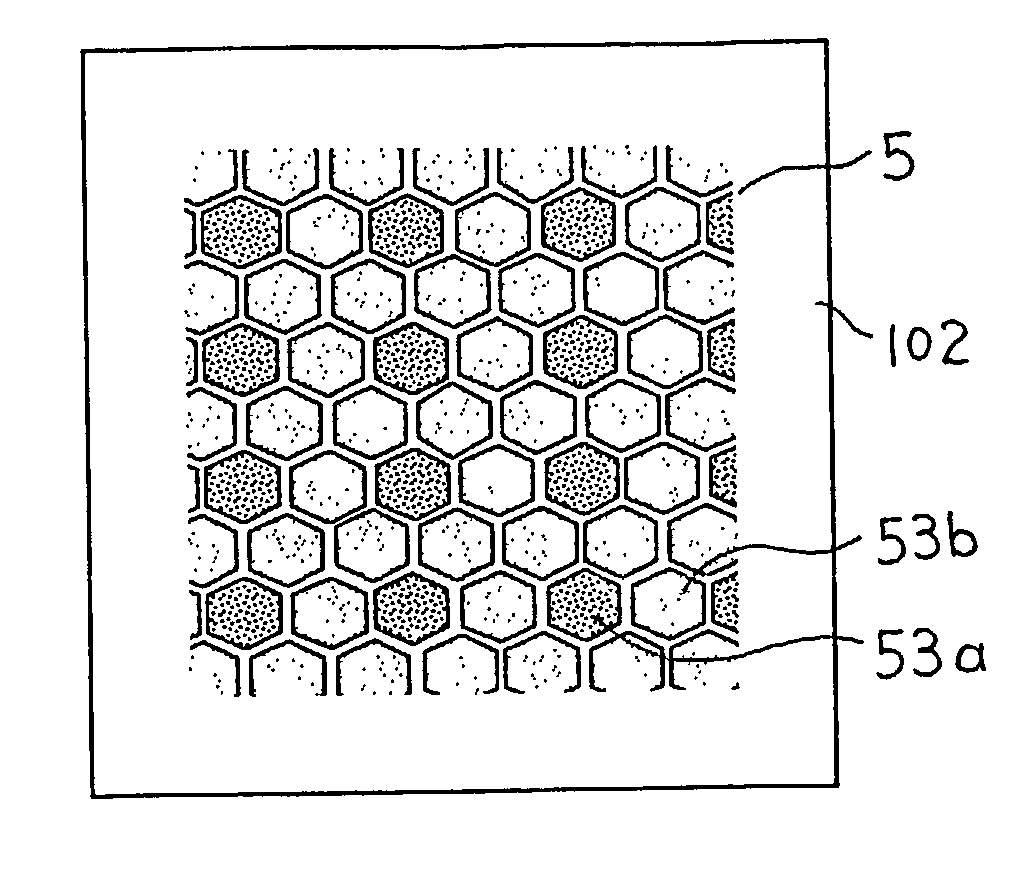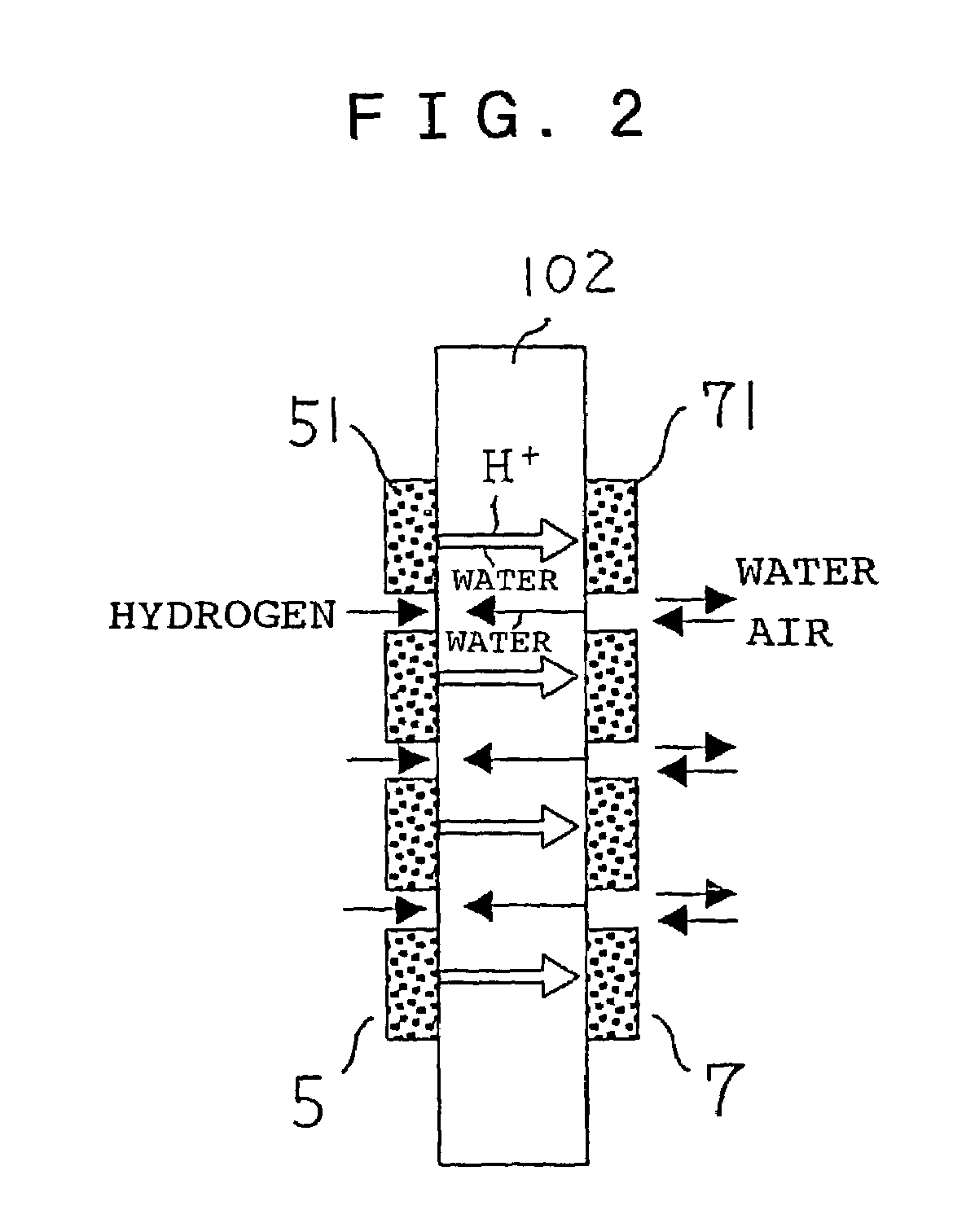Fuel cell
a fuel cell and solid-state technology, applied in the field of solid-state polymer fuel cells, can solve the problems of increasing danger, insufficient air supplied to the cathode catalyst layer, and inability to smoothly effected reaction in the cathode 104/b>, and achieve the effect of high reliability
- Summary
- Abstract
- Description
- Claims
- Application Information
AI Technical Summary
Benefits of technology
Problems solved by technology
Method used
Image
Examples
embodiment 1
[0031]FIGS. 1A and 1B are a top view and a side view, respectively, schematically showing a structure of main portions of a fuel cell of Embodiment 1 according to the present invention. In FIGS. 1A and 1B, a fuel cell 1 includes an electrolyte membrane 102, an anode 3 (corresponding to the anode 103 in FIG. 8) that is in contact with one surface of the electrolyte membrane 102, and a cathode 4 (corresponding to the cathode 104 in FIG. 8) that is in contact with the other surface of the electrolyte membrane 102. The anode 3 includes an anode catalyst layer 5 applied to the electrolyte membrane 102, and a fuel-side gas diffusion layer 106 overlapped with the anode catalyst layer 5. The cathode 4 includes a cathode catalyst layer 7 applied to the electrolyte membrane 102, and an air-side gas diffusion layer 108 overlapped with the cathode catalyst layer 7.
[0032]The anode catalyst layer 5 has a plurality of divided catalyst segments 51. The shape of each of the divided catalyst segments...
embodiment 2
[0041]FIGS. 3A to 3C are views schematically showing a structure of main portions of a fuel cell in accordance with Embodiment 2 of the present invention. FIG. 3A is a front view seen from an anode side. FIG. 3B is a front view thereof seen from a cathode side. FIG. 3C is a side view thereof. In FIGS. 3A to 3C, a fuel cell 1 includes an electrolyte membrane 102, an anode 3 that is in contact with one surface of the electrolyte membrane 102, and a cathode 4 that is in contact with the other surface of the electrolyte membrane 102. The anode 3 includes an anode catalyst layer 5 applied to the electrolyte membrane 102, and a fuel-side gas diffusion layer 106 overlapped with the anode catalyst layer 5. The cathode 4 includes a cathode catalyst layer 7 applied to the electrolyte membrane 102, and the air-side gas diffusion layer 108 overlapped with the cathode catalyst layer 7.
[0042]The anode catalyst layer 5 includes hydrophilic divided catalyst segments 52a and water-repellent divided ...
embodiment 3
[0050]FIGS. 4A and 4B are views schematically showing a structure of main portions of a fuel cell in accordance with Embodiment 3 of the present invention. FIG. 4A is a front view seen from an anode side. FIG. 4B is a side view thereof. In FIGS. 4A and 4B, an anode catalyst layer 5 includes divided catalyst segments 53a and divided catalyst segments 53b, which have different compositions of a metal catalyst. In the divided catalyst segments 53a, a platinum-ruthenium alloy (atomic ratio between platinum and ruthenium=2:1) is used as a metallic catalyst. In the divided catalyst segments 53b, a platinum-ruthenium alloy (atomic ratio between platinum and ruthenium=1:2) is used as a metal catalyst. Furthermore, herein, the total area of the divided catalyst segments 53a is three times that of the divided catalyst segments 53b. The shape of each of the divided catalyst segments 53a and 53b or the gaps therebetween are the same as those in Embodiment 1, and the remaining structure is also ...
PUM
| Property | Measurement | Unit |
|---|---|---|
| current density | aaaaa | aaaaa |
| width | aaaaa | aaaaa |
| area | aaaaa | aaaaa |
Abstract
Description
Claims
Application Information
 Login to View More
Login to View More - R&D
- Intellectual Property
- Life Sciences
- Materials
- Tech Scout
- Unparalleled Data Quality
- Higher Quality Content
- 60% Fewer Hallucinations
Browse by: Latest US Patents, China's latest patents, Technical Efficacy Thesaurus, Application Domain, Technology Topic, Popular Technical Reports.
© 2025 PatSnap. All rights reserved.Legal|Privacy policy|Modern Slavery Act Transparency Statement|Sitemap|About US| Contact US: help@patsnap.com



